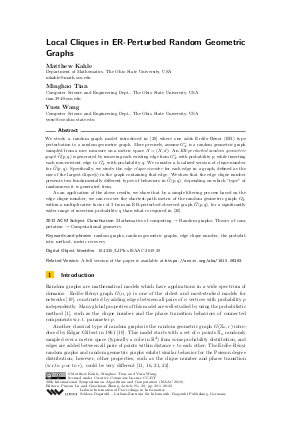Local Cliques in ER-Perturbed Random Geometric Graphs
Authors Matthew Kahle, Minghao Tian, Yusu Wang
-
Part of:
Volume:
30th International Symposium on Algorithms and Computation (ISAAC 2019)
Part of: Series: Leibniz International Proceedings in Informatics (LIPIcs)
Part of: Conference: International Symposium on Algorithms and Computation (ISAAC) - License:
 Creative Commons Attribution 3.0 Unported license
Creative Commons Attribution 3.0 Unported license
- Publication Date: 2019-11-28
File

PDF
LIPIcs.ISAAC.2019.29.pdf
- Filesize: 0.69 MB
- 22 pages
Document Identifiers
Related Versions
-
A full version of the paper is available at https://arxiv.org/abs/1810.08383.
Subject Classification
ACM Subject Classification
- Mathematics of computing → Random graphs
- Theory of computation → Computational geometry
Keywords
- random graphs
- random geometric graphs
- edge clique number
- the probabilistic method
- metric recovery
Metrics
- Access Statistics
-
Total Accesses (updated on a weekly basis)
0Document
0Metadata
Abstract
We study a random graph model introduced in [Srinivasan Parthasarathy et al., 2017] where one adds Erdős - Rényi (ER) type perturbation to a random geometric graph. More precisely, assume G_X^* is a random geometric graph sampled from a nice measure on a metric space X = (X,d). An ER-perturbed random geometric graph G^(p,q) is generated by removing each existing edge from G_X^* with probability p, while inserting each non-existent edge to G_X^* with probability q. We consider a localized version of clique number for G^(p,q): Specifically, we study the edge clique number for each edge in a graph, defined as the size of the largest clique(s) in the graph containing that edge. We show that the edge clique number presents two fundamentally different types of behaviors in G^(p,q), depending on which "type" of randomness it is generated from. As an application of the above results, we show that by a simple filtering process based on the edge clique number, we can recover the shortest-path metric of the random geometric graph G_X^* within a multiplicative factor of 3 from an ER-perturbed observed graph G^(p,q), for a significantly wider range of insertion probability q than what is required in [Srinivasan Parthasarathy et al., 2017].
Cite As Get BibTex
Matthew Kahle, Minghao Tian, and Yusu Wang. Local Cliques in ER-Perturbed Random Geometric Graphs. In 30th International Symposium on Algorithms and Computation (ISAAC 2019). Leibniz International Proceedings in Informatics (LIPIcs), Volume 149, pp. 29:1-29:22, Schloss Dagstuhl – Leibniz-Zentrum für Informatik (2019)
https://doi.org/10.4230/LIPIcs.ISAAC.2019.29
BibTex
@InProceedings{kahle_et_al:LIPIcs.ISAAC.2019.29,
author = {Kahle, Matthew and Tian, Minghao and Wang, Yusu},
title = {{Local Cliques in ER-Perturbed Random Geometric Graphs}},
booktitle = {30th International Symposium on Algorithms and Computation (ISAAC 2019)},
pages = {29:1--29:22},
series = {Leibniz International Proceedings in Informatics (LIPIcs)},
ISBN = {978-3-95977-130-6},
ISSN = {1868-8969},
year = {2019},
volume = {149},
editor = {Lu, Pinyan and Zhang, Guochuan},
publisher = {Schloss Dagstuhl -- Leibniz-Zentrum f{\"u}r Informatik},
address = {Dagstuhl, Germany},
URL = {https://drops.dagstuhl.de/entities/document/10.4230/LIPIcs.ISAAC.2019.29},
URN = {urn:nbn:de:0030-drops-115253},
doi = {10.4230/LIPIcs.ISAAC.2019.29},
annote = {Keywords: random graphs, random geometric graphs, edge clique number, the probabilistic method, metric recovery}
}
Author Details
References
-
Noga Alon and Joel Spencer. The Probabilistic Method. Wiley Publishing, 4th edition, 2016.

-
Philippe Blanchard and Dimitri Volchenkov. Mathematical analysis of urban spatial networks. Springer Science & Business Media, 2008.

-
Béla Bollobás and Oliver Riordan. Percolation. Cambridge University Press, 2006.

-
Lorna Booth, Jehoshua Bruck, Matthew Cook, and Massimo Franceschetti. Ad hoc wireless networks with noisy links. In Proceedings of IEEE International Symposium on Information Theory, pages 386-386. IEEE, 2003.

-
Martin R Bridson and André Haefliger. Metric spaces of non-positive curvature, volume 319. Springer Science & Business Media, 2011.

-
Don Coppersmith, David Gamarnik, and Maxim Sviridenko. The Diameter of a Long-Range Percolation Graph, pages 147-159. Birkhäuser Basel, Basel, 2002.

-
Carl Dettmann and Orestis Georgiou. Random geometric graphs with general connection functions. Physical Review E, 93(3):032313, 2016.

-
Herbert Federer. Geometric measure theory. Springer, 2014.

-
Janos Galambos. Bonferroni inequalities. The Annals of Probability, pages 577-581, 1977.

-
Edward Gilbert. Random plane networks. Journal of the Society for Industrial and Applied Mathematics, 9(4):533-543, 1961.

-
Piyush Gupta and Panganamala Kumar. Critical power for asymptotic connectivity in wireless networks. In Stochastic analysis, control, optimization and applications, pages 547-566. Springer, 1999.

-
Juha Heinonen. Lectures on analysis on metric spaces. Springer Science & Business Media, 2012.

-
Svante Janson, Róbert Kozma, Miklós Ruszinkó, and Yury Sokolov. Bootstrap percolation on a random graph coupled with a lattice. Electronic Journal of Combinatorics, 2016.

-
Antti Kaenmaki, Tapio Rajala, and Ville Suomala. Local homogeneity and dimensions of measures. Annali Della Scoula Normale Superiore Di Pisa-Classe Di Scienze, 16(4):1315-1351, 2016.

- Matthew Kahle, Minghao Tian, and Yusu Wang. Local cliques in ER-perturbed random geometric graphs. arXiv preprint, 2018. URL: http://arxiv.org/abs/1810.08383.
-
Colin McDiarmid and Tobias Müller. On the chromatic number of random geometric graphs. Combinatorica, 31(4):423-488, 2011.

-
Ronald Meester and Rahul Roy. Continuum percolation, volume 119. Cambridge University Press, 1996.

-
Maziar Nekovee. Worm epidemics in wireless ad hoc networks. New Journal of Physics, 9(6):189, 2007.

-
Mark Newman. Random graphs as models of networks. Handbook of Graphs and Networks: From the Genome to the Internet, pages 35-68, 2002.

- Srinivasan Parthasarathy, David Sivakoff, Minghao Tian, and Yusu Wang. A Quest to Unravel the Metric Structure Behind Perturbed Networks. In 33rd International Symposium on Computational Geometry, SoCG 2017, July 4-7, 2017, Brisbane, Australia, pages 53:1-53:16, 2017. URL: https://doi.org/10.4230/LIPIcs.SoCG.2017.53.
-
Mathew Penrose. The longest edge of the random minimal spanning tree. Ann. Appl. Probab., 7(2):340-361, May 1997.

-
Mathew Penrose. Random geometric graphs, volume 5. Oxford University Press, 2003.

-
Gareth Peters and Tomoko Matsui. Theoretical Aspects of Spatial-Temporal Modeling. Springer, 2015.

-
Xian Yuan Wu. Mixing Time of Random Walk on Poisson Geometry Small World. Internet Mathematics, 2017.

